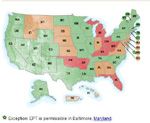STI Reinfection Rates Reduced by Expedited Partner Therapy
When chlamydia or gonorrhea is diagnosed in female patients, obstetricians and gynecologists should also prescribe antibiotics for the male partners. This recommendation comes from The American College of Obstetricians and Gynecologists in efforts to reduce the high reinfection rates associated with these sexually transmitted infections (STIs).
When chlamydia or gonorrhea is diagnosed in female patients, obstetricians and gynecologists should also prescribe antibiotics for the male partners.1 This recommendation comes from The American College of Obstetricians and Gynecologists in efforts to reduce the high reinfection rates associated with these sexually transmitted infections (STIs). The practice, known as expedited partner therapy (EPT), allows a physician to provide a prescription for antibiotics or the antibiotics themselves to the female patient to take to her male sexual partner, who is either unwilling or unable to seek treatment.
Untreated STIs can cause infertility in both men and women, but these infections disproportionately affect women and their fertility. In the United States, chlamydia and gonorrhea are the most common STIs, with women aged 15 to 24 years affected most often. In the 12-month period after chlamydia is diagnosed, the rate of reinfection is as high as 26%, often because a male sexual partner is also infected. Symptoms of chlamydia and gonorrhea can be absent or very general, such as cramping, abnormal vaginal bleeding, or vaginal or penile discharge. A simple urine test can confirm the diagnosis of chlamydia or gonorrhea, and a short course of antibiotics can treat the STIs.
According to the latest figures from the CDC, 30 states allow for the prescribing of antibiotics to nonpatients without prior examination, 13 states consider it potentially allowable, and 7 states prohibit the practice (Figure).2 The College encourages obstetricians and gynecologists who practice in states in which EPT is illegal or has an ambiguous legal status to petition for legalization of this practice.
Figure. Legal Status of EPT as of August 10, 2011

EPT is permissible
EPT is potentially allowable
Related Content
Addressing Low HPV Vaccination Rates: Physicians May Need to Step-Up Recommendation PracticesFDA Approves New HPV Test
References:
References
1. Committee opinion no. 506: expedited partner therapy in the management of gonorrhea and chlamydia by obstetricians-gynecologists. Obstet Gynecol. 2011;118:761-766.
2. Division of STD Prevention, National Center for HIV/AIDS, Viral Hepatitis, STD, and TB Prevention, Centers for Disease Control and Prevention. Legal status of EPTs-summary totals. August 10, 2011. Accessed September 12, 2011.
In this episode of Pap Talk, Gloria Bachmann, MD, MSc, breaks down what it means to be a health care provider for incarcerated individuals, and explores the specific challenges women and their providers face during and after incarceration. Joined by sexual health expert Michael Krychman, MD, Bachmann also discusses trauma-informed care and how providers can get informed.
Listen
